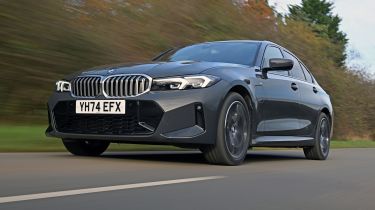New BMW 330e 2024 review: one of the best plug-in company cars you can buy
The facelifted BMW 330e PHEV is a top business choice

Verdict
Better than ever, there really is little reason to consider anything else if you’re in the market for a plug-in hybrid company car that’s as comfortable to sit in as it is to drive. The BMW 3 Series – and in particular this 330e plug-in hybrid – really does represent the best of both worlds for those wanting to dip their toe into the world of electrification (and save on their tax bill), but not yet ready to commit to a full EV. Keep it charged and there’s no better EV-lite driving experience currently on sale.
The BMW 3 Series has been the company car driver’s benchmark for more than four decades. Ever since its inception, it’s been the default choice for those who’ve climbed the corporate ladder and want to show off their status with the famous white, black and blue badge on the bootlid.
Yet with the electric car’s recent dominance in the fleet market, BMW had to do something serious to keep its saloon stalwart competitive. With an all-new 3 Series still a year or so off, that meant tweaking the formula with a second mid-life facelift – simply to tide over the G20 generation before its successor is deemed ready for release.
Used - available now

2022 BMW
3 Series
68,030 milesAutomaticPetrol2.0L
Cash £15,495
2022 BMW
3 Series
20,120 milesAutomaticPetrol2.0L
Cash £23,495
2022 BMW
3 Series
48,466 milesAutomaticDiesel2.0L
Cash £21,283
2022 BMW
3 Series
53,629 milesAutomaticPetrol2.0L
Cash £17,516So in May this year, BMW announced a series of updates to bring the fight to electric cars alternatives such as the Tesla Model 3 and Polestar 2, as well as historical rivals like the Mercedes C-Class and Audi A5 (nee A4).
The tweaks to the 3 Series are mostly mechanical. There’s no 320d diesel anymore, which means the most significant change relates to the big-selling 330e plug-in hybrid’s high-voltage battery. A new 19.5kWh unit now allows for an official 62 miles of electric running in the M Sport car we have here (63 miles in the more modest Sport spec), which means a theoretical 350-odd miles per gallon and CO2 emissions as low as 19g/km.
Of course, while that’s pie-in-the-sky kind of stuff, it does mean you’ll get significantly more zero-emissions range out of your 330e than you might have done before (36 miles was the previous car’s stated maximum), and it drops a Benefit-in-Kind (BiK) band in the process. At eight per cent, it’s still a good chunk more than you’ll pay running an EV (two per cent), but with the added reassurance that if you regularly do big miles you’ve got a powerful petrol engine to fall back on. Do so, and you’ll easily see 40mpg or more at motorway speeds.
Yet that bigger battery means that most of the time – so long as you keep the car topped up – you’ll be gliding around using no ‘fuel’ at all. As ever, the 330e feels perfectly suited to electric running, just as its i4 EV sibling does, with excellent refinement and a decent turn of speed. The low-speed ride is nicely judged, feeling controlled but never harsh.
Indeed, when BMW announced the revised car, it claimed the chassis had undergone “rigorous development work”, apparently resulting in a “notable increase in comfort across all driving situations, without any loss of the customary 3 Series dynamic prowess”.
This dynamic prowess is a character trait that has spanned every generation of 3 Series, and it’s not lost here – no matter how fast you’re travelling. In fact, aside from the polarising thick-rimmed steering wheel, there’s little not to like about driving the 3. There’s a precision to the car’s dynamics that is lost in almost all of this car’s rivals; the 330e, despite its hefty kerb weight of more than 1,900kg, is about as close to a sports saloon as you’ll get for under £50,000.
The rear-drive chassis feels playful, with sharp turn-in and plenty of grip. There’s very little roll through fast changes of direction, making it easy to find a flow over a winding back road. That flow is just as evident on the motorway, too, where the BMW moves gently with larger undulations and settles neatly into a composed cruise.
Many high-mileage motorists will lament the demise of diesel, but the powers that be have all but eliminated its usefulness by implementing hefty tax rules for anything without a bulky battery. As such, the plug-in hybrid has become the business buyers’ powertrain of choice – regardless of whether they make the most of the EV range or not.
By and large, the hybrid system works well. The transition between petrol and electric is almost always seamless – so long as you’re not rolling up to a junction on the brakes and flooring the throttle when you spot a gap in the traffic. Like most similar set-ups, this is where the 330e comes unstuck – it’s simply unable to juggle the two power sources in the blink of an eye, so there’s a momentary pause as you wait for the ICE to wake up.
But when it’s spinning, this is a genuinely fast car. BMW quotes a 0-62mph time of 5.9 seconds, meaning it can show myriad hot hatches a clean pair of heels if you flick it into Sport mode and use the combined 288bhp of the engine and electric motor. In its most dynamic setting you’ll get a jolt with each gear change, too; it may not feel as fast or linear as an EV, but there’s no disputing the engagement on offer.
Thankfully, the 330e’s larger-capacity battery has no impact on interior or boot space – although at 375 litres, it remains 100-or-so litres down on the mild-hybrid 320. Should this be an issue, however, BMW continues to offer the PHEV layout as a Touring estate (for an extra £1,800), with the added benefit that bulky belongings can be loaded to the roof instead of being compromised by the letterbox-style saloon boot opening.
Interior quality is right up there with the very best cars in this part of the market – petrol, PHEV or EV. The curved twin-screen infotainment runs the latest OS 8.5 software and is as sharp as you like, retaining the intuitive iDrive clickwheel on the centre console. That said, if you prefer to use Apple CarPlay or Android Auto, this feature will feel rather archaic; every function can be accessed via the responsive touchscreen, after all. Some, like the climate controls, are now housed in a permanent ‘Quickselect’ panel along its base.
Another change made to the 330’s technical make-up is the fitment of a new 11kW on-board charger. While that won’t be of much benefit to those charging at home on a regular single-phase wallbox, if you make use of work or public points with a three-phase connection, it could reduce top-up times to as little as two hours and 15 minutes. DC fast charging, which seems to be becoming more popular with the introduction of longer-range PHEVs, is not an option on the 3 Series.
With regards to range and specifications, M Sport continues to account for a huge proportion of 3 Series sales, and it’s easy to see why. While all versions get at least 18-inch wheels, the M Sport’s racier body kit cuts a much more athletic profile, with a wider front grille and a slightly lower stance. Inside, there’s darker trim and M Sport seats with different upholstery. You’ll only pay £1,250 more for this spec, which becomes almost negligible on a competitive lease deal or PCP agreement.
The options list is long and varied, ranging from different wheel designs to expensive paint – our car’s rather uninspiring Davit Grey metallic was a £1,725 extra. Also fitted to our test car was the Technology Pack (£2,100) and the Comfort Pack (£1,575). The former adds BMW’s Driving Assistant with adaptive cruise control and other safety features, plus a head-up display and self-park function. The latter, meanwhile, brings lumbar support for the front seat, plus an automatic bootlid, keyless entry and start, wireless phone charging and ambient lighting. All of this bumped the price to more than £55k.
That said, a Mercedes C 300 e AMG Line starts at almost £52,000 without a single option. You might save a few pennies on BiK – the Merc sits in the five per cent tax bracket, as opposed to the BMW’s eight per cent rating – but you’ll need to step up to Premium trim for things like the electric tailgate or keyless go.
Maybe the forthcoming Audi A5 TFSIe can turn this segment on its head when it arrives later in 2025. But for now, the baby BMW is back at its best.
| Model: | BMW 330e M Sport |
| Price: | £48,235 |
| On sale: | Now |
| Powertrain: | 2.0-litre four-cyl turbo petrol PHEV |
| Power/torque: | 288bhp/420Nm |
| Transmission: | Eight-speed automatic, rear-wheel drive |
| 0-62mph/top speed: | 5.9 seconds/143mph |
| Economy: | 353.1mpg |
| EV range: | 62 miles |
| CO2: | 19g/km |
| Size (L/W/H): | 4,713/1,827/1,446mm |










